Graduates of the MSU MFA Program at NASA
By Wade Sisler (Executive Television Producer at NASA Goddard Space Flight Center)
We met Ron Tobias just as the Science and Natural History Filmmaking Program was getting underway and were immediately intrigued with the possibility of working with students who had such an innate passion for communicating science they would pick up their lives and endure the harsh winters of Montana.
To understand how we view the MSU producer, you have to understand something about NASA Goddard. Goddard is NASA's largest science center and supports vibrant research in four major science themes - astrophysics, heliophysics, planetary, and especially Earth Science.
Goddard may have the largest concentration of scientists on the planet, and one of the biggest challenges of working here is finding producers who can think like scientists and be trusted by scientists. Scientists prefer to work with producers who can accurately translate their story, have a grasp of the scientific process, and share their sense of curiosity and wonder.
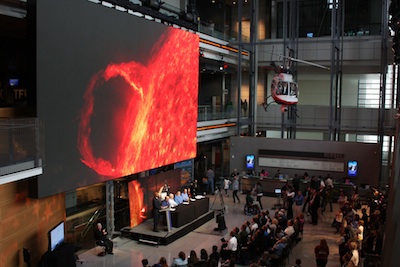
NASA press event on first images from the new solar observing Solar Dynamics Laboratory
held at the Newseum. SNHF MFA alumnus Scott Wiessinger's SDO images received saturation
coverage in news media.
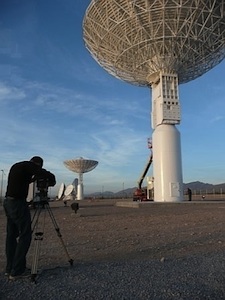
SNHF alumnus Andy Freeberg records a radio telescope.
The alignment of MSU's filmmaking program with science is what sets it apart and makes your students such competitive candidates. I think MSU's model of starting with scientists and developing their storytelling and technical capabilities is perfect fit for NASA.
MSU alums are famously passionate and filled with curiosity. One of the things I've noticed is they tend to see possible stories everywhere. They are connectors and consensus builders and our scientists and engineers love working with them.
We've been lucky to employ nine MSU grads during the past ten years. About half of the students were working toward their MFA and half were fresh outs. We ask for at least a year commitment since it can take a while to get your bearings in such a large organization.
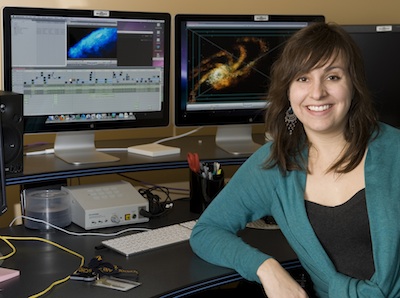
SNHF alumna Stephanie Watkins taking a break from editing.
MSU producers begin as members of storytelling tiger teams supporting specific satellite missions or science themes. They work with world class science writers, animators, data visualizers, and web producers... and I think they might just have one of the most fun jobs on the planet. These teams are literally on the unfiltered, cutting edge of science and discovery. Their job is to take a scientist's eureka moment - often something never seen before - translate the story, make it visually compelling, and figure out clever ways of sharing it with the widest possible audience.
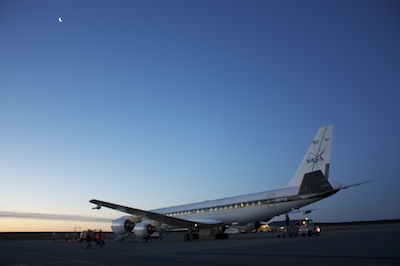
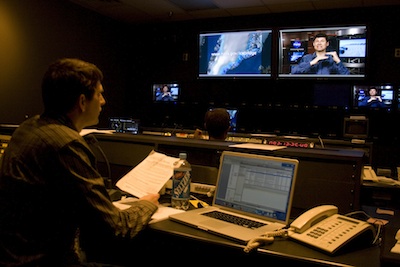
For Operation IceBridge, SNHF alumnus Jefferson Beck (r) flew to Greenland and produced the Icebridge satellite media tour with 20 broadcast stations.
As student producers gradually gain experience, they often become leaders in these
storytelling teams, and help the team create mind-blowing and versatile core content.
That's a huge part of the work. The essential visual elements for our stories tend
to be created with the virtual cameras via data visualization and animation.
These tasks employ the same basic storytelling skills as shooting wildlife, but applied
towards remote sensing or the physical sciences. Once we have the core elements rendered
in high resolution, we make them available via to filmmakers, news media, museum content
creators, educators and the general public through our extensive online resource collections.
Producers also weave these products a variety of short form finished productions distributed
via NASA-TV, nasa.gov, and our social media spigots.
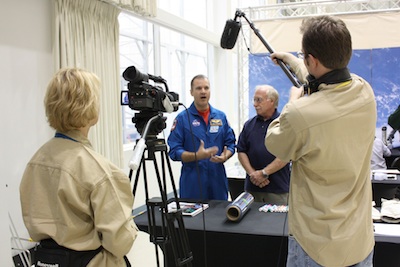
SNHF alumnus Ryan Fitzgibbons (r) holding the microphone during an interview for the
Discovery Channel / Young Science Challenge.
MSU producers are strong storytellers who know their way around the scientific process. The most successful producers have very strong technical skills and hopefully, a great eye. Editing, writing, and project management skills are especially important. Each producer is issued a laptop with FCP and can edit at their desk or plug into one of our finishing suites. We're not a huge shop, so our team members occasionally operate cameras or crew for each other.
